Strategies for Scalable Game User Acquisition
Are you struggling to effectively scale your mobile game's user base? In mobile gaming, attracting players isn't just about creating a great game; it's about implementing the proper user acquisition (UA) strategies. Without a data-driven UA plan, even top-rated games may fail to break through increasing user acquisition costs.
To stand out, you need a comprehensive approach that combines creativity, data-driven decisions, and continuous optimization. If you're facing challenges like high user acquisition costs, low conversion rates, or ineffective ad creatives, you're not alone. Many developers encounter these hurdles when trying to grow their user base.
This blog explores proven strategies for scalable game acquisition. We'll explore how to optimize your ad creatives, leverage targeted campaigns, and implement the hybrid acquisition model to attract high-quality users and drive sustainable growth.
Understanding Scalable Game User Acquisition
Scalable game user acquisition is about attracting and retaining a growing number of players efficiently, ensuring that your marketing efforts lead to sustainable growth without proportional increases in cost. In the mobile gaming industry, it's crucial to implement strategies that let you expand your player base while maintaining cost-effectiveness.
It includes:
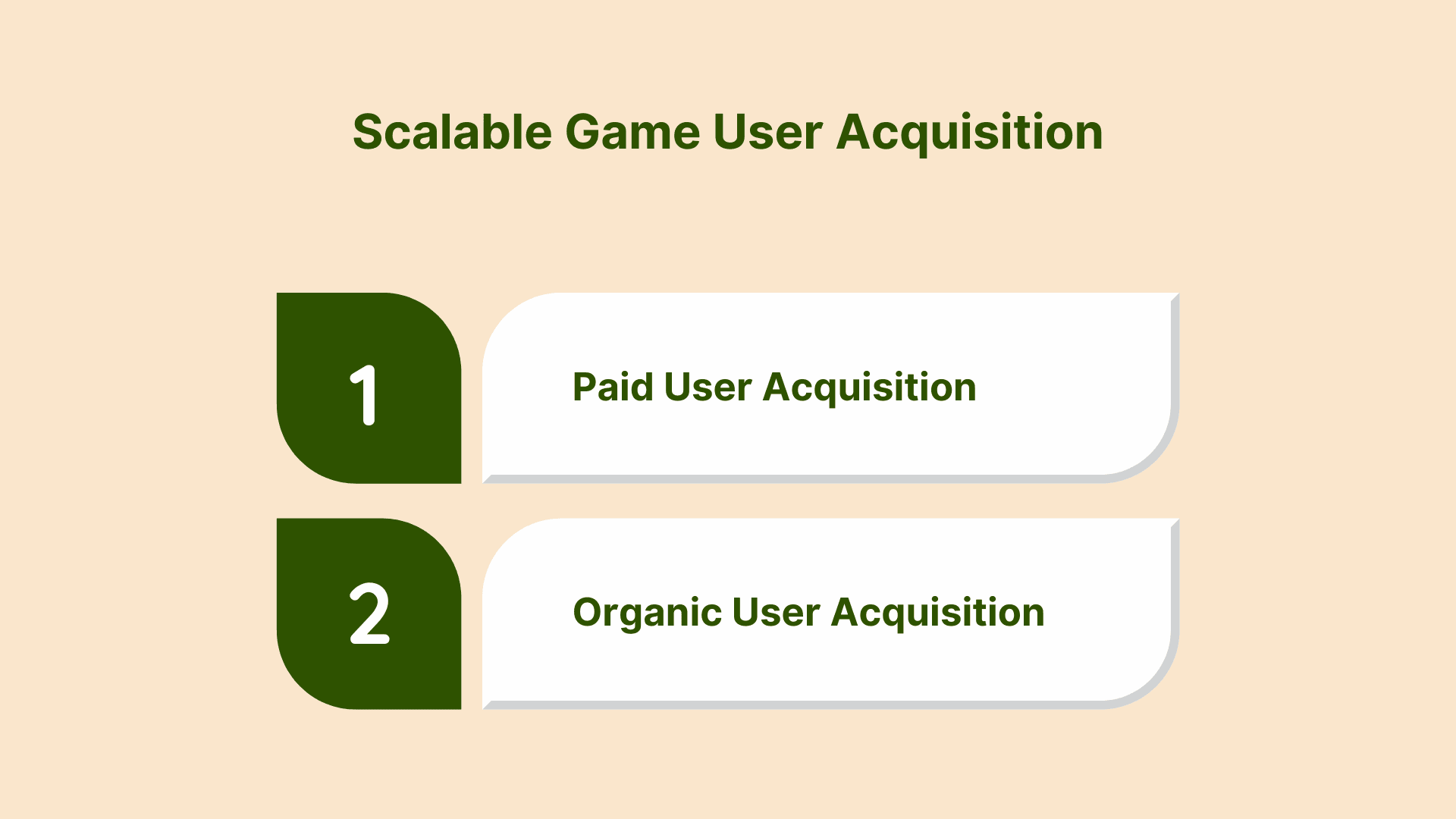
Paid User Acquisition: Utilizing advertising platforms to reach a broad audience. This includes strategies like social media ads and influencer partnerships. Paid user acquisition can rapidly increase your game's visibility and attract a large number of players. However, it's essential to monitor and optimize these campaigns continuously to ensure a positive return on investment.
Organic User Acquisition: Leveraging app store optimization (ASO) and content marketing to attract users without direct advertising. Organic methods focus on establishing a strong presence and reputation, resulting in sustained growth over time. While it may take longer to see results compared to paid strategies, organic acquisition offers a cost-effective way to build a loyal player base.
A balanced approach combining both paid and organic strategies ensures a steady influx of players and enhances your game's visibility and credibility. By integrating these methods, you can reach a broader audience and attract more players in the mobile gaming market.
To ensure long-term success, it's essential to recognize the importance of scalable acquisition strategies. Here's why scalable user acquisition matters:
Also Read: Creative Optimization in 2025: Actionable Insights Report
Why Scalable Acquisition Matters?

With over 700 thousand games available on major app stores, standing out requires more than just a great game; it demands strategic, scalable user acquisition (UA) efforts. Without a scalable approach, even the most engaging games can struggle to build a substantial player base.
Here are the main reasons why scalable user acquisition is essential for mobile games:
Market Saturation: The mobile gaming market is saturated, with hundreds of new games launching daily. This influx makes it challenging to capture the player's attention. A scalable acquisition strategy that combines both paid and organic methods is essential to reach a broader audience and maintain a competitive edge.
Cost Efficiency: User acquisition costs have surged, with the average cost per install (CPI) for casual games on iOS climbing to $4.83 between March 2023 and March 2024. Scalable acquisition strategies help in managing these costs effectively, ensuring that marketing efforts lead to sustainable growth without proportional increases in cost.
Long-Term Growth: Focusing on scalable user acquisition fosters a loyal player base, resulting in improved player lifetime value. By attracting users who are genuinely interested in your game, you build a community that supports long-term success.
To successfully implement scalable acquisition, it's essential to explore the right strategies that can efficiently drive growth.
Strategies for Scalable Game User Acquisition
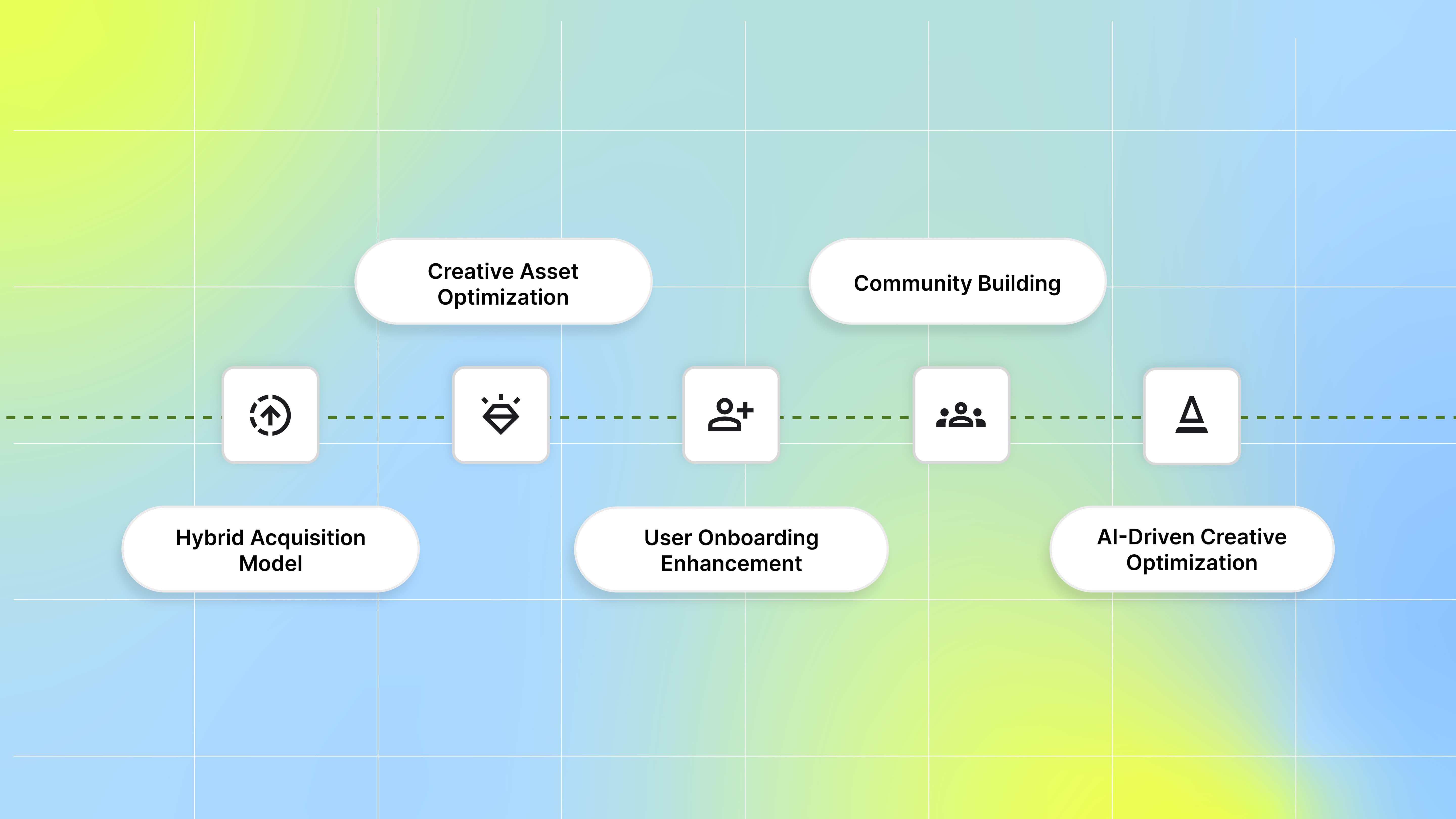
To achieve sustainable growth, mobile game developers must implement strategies that efficiently attract new players. Balancing both paid and organic acquisition tactics is key to maximizing reach.
Here are some of the strategies that can help scale your game's user acquisition efforts:
1. Implementing a Hybrid Acquisition Model
A hybrid acquisition model combines paid advertising with organic growth tactics to maximize user acquisition. Paid strategies provide immediate visibility and reach, while organic methods build long-term engagement and credibility. This balanced approach helps in acquiring new players efficiently without over-reliance on a single channel.
Here are some of the paid strategies:
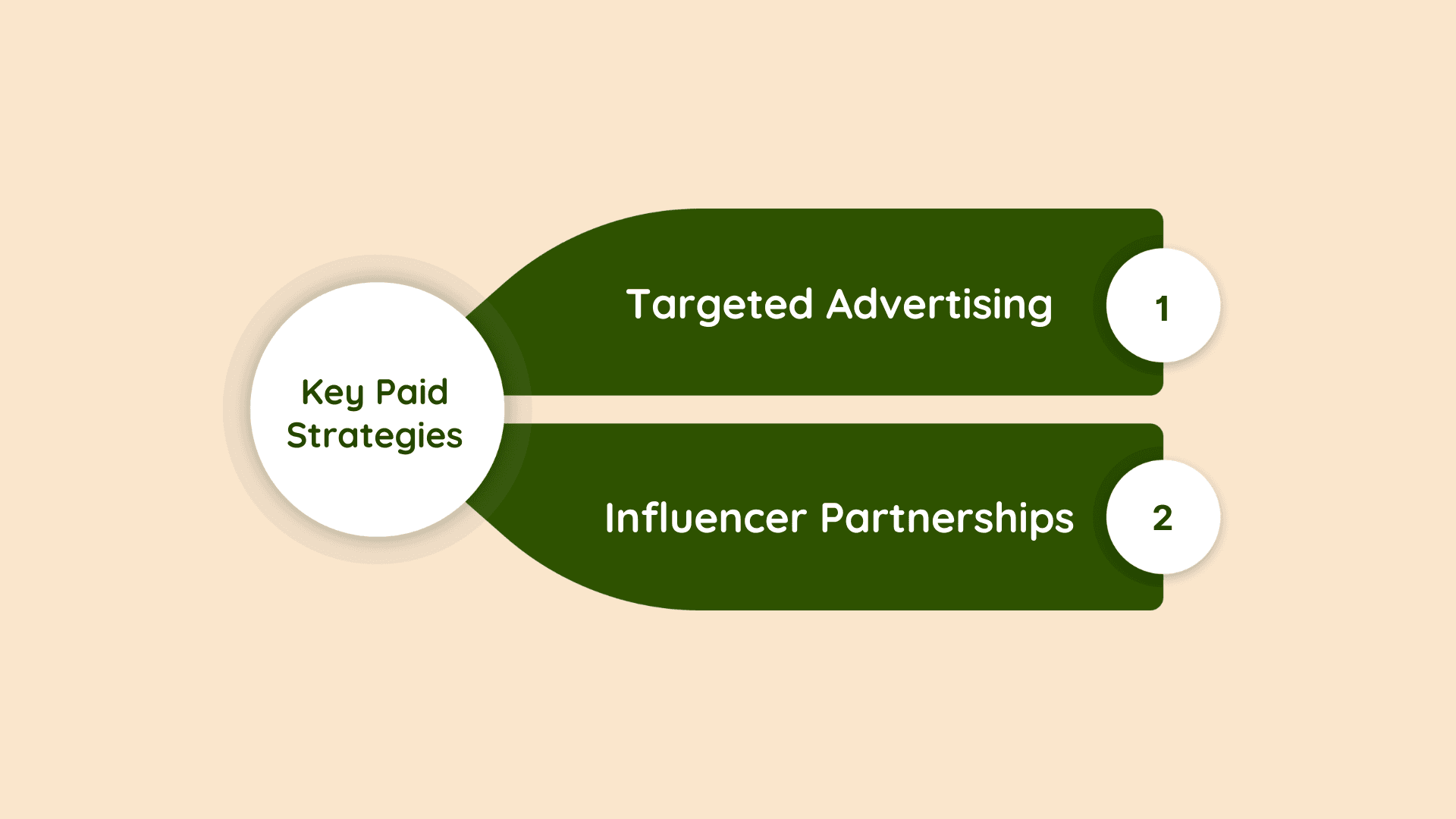
Targeted Advertising
Targeted advertising involves using data-driven platforms to deliver ads to specific user segments based on demographics, behaviors, and device attributes. You can utilize platforms such as:
AppLovin: Utilizes its AI engine, Axon 2.0, to analyze vast datasets and predict which users are most likely to install and engage with your game. This predictive modeling ensures that ads reach high-intent users, optimizing return on ad spend (ROAS).
Unity Ads: Offers performance campaigns powered by Vector, Unity's advanced AI model, which targets audiences likely to engage and convert, enhancing user acquisition efficiency.
How It Helps: This precision ensures that your game is showcased to potential players who are more likely to install and engage. By focusing your ad spend on these segments, you can increase your user acquisition rate and reduce cost per install (CPI).
Why It Matters: Targeted advertising enables efficient use of marketing budgets, ensuring that resources are spent on reaching the most relevant audience, leading to higher conversion rates and better ROI.
Influencer Partnerships
Influencer partnerships in mobile game user acquisition involve collaborating with content creators, such as streamers, YouTubers, and social media personalities, who have established trust and a dedicated following within the gaming community.
How It Helps: Influencers provide social proof, making their followers more likely to trust and try your game. Their content can showcase your game in an engaging and relatable manner, highlighting its features and gameplay mechanics. This authentic exposure can lead to increased installs and a more engaged user base.
For example, PUBG Mobile teamed up with Viral Nation for its North American launch, activating 38 influencers (including PewDiePie and MrBeast) across YouTube and Instagram. This drove 78.8 million total impressions and 447,100 clicks to install the app in under 30 days.
Why It Matters: Influencer partnerships offer access to targeted audiences who are already interested in gaming content. By leveraging the influence and credibility of these creators, you can effectively reach potential players, build brand awareness, and foster a loyal community around your game.
Here are some of the Organic strategies:
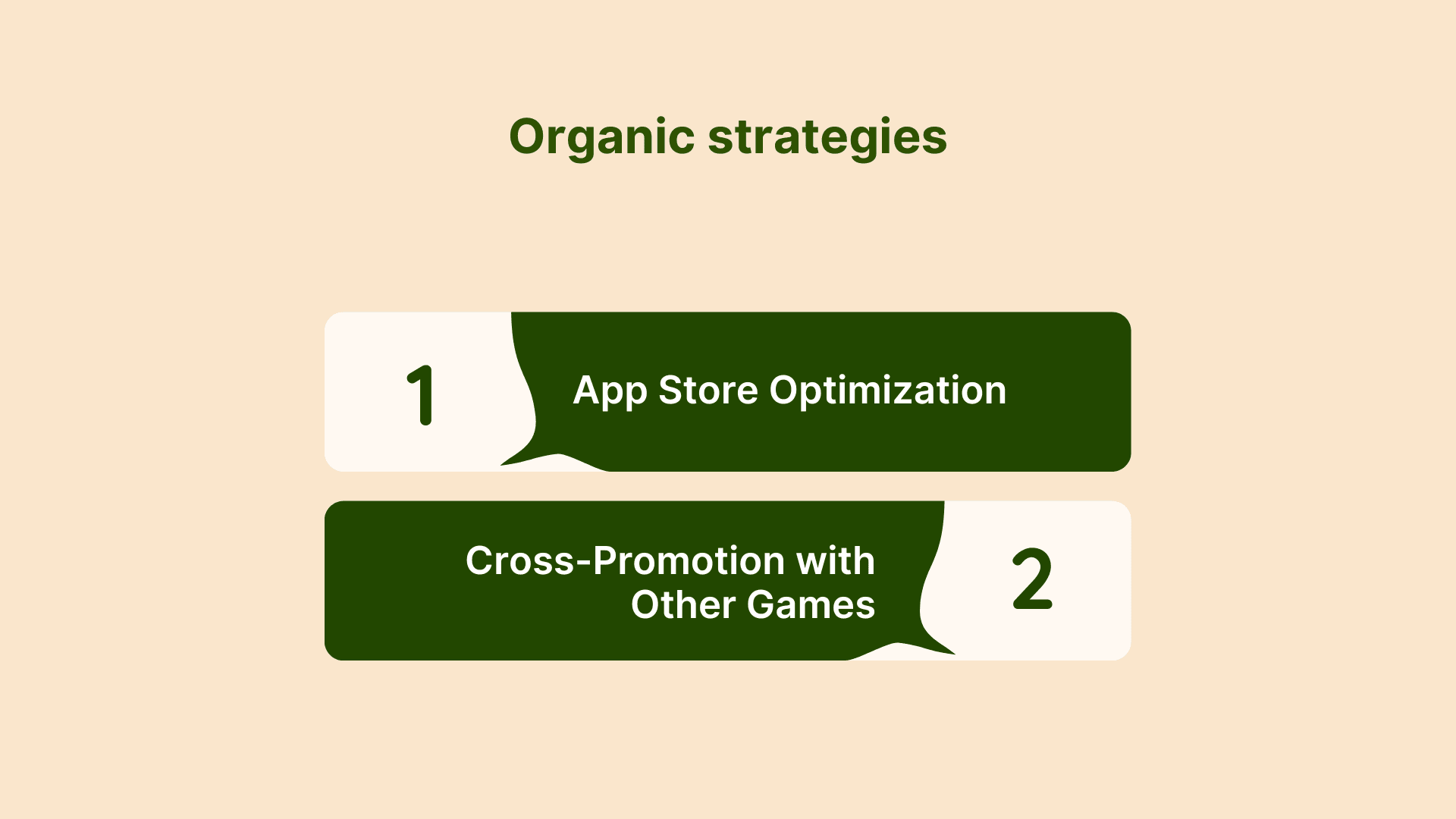
App Store Optimization (ASO)
App Store Optimization involves optimizing your game's title, description, keywords, and visuals to improve its visibility in app store search results.
How It Helps: By aligning your game's metadata with relevant search terms, you increase the likelihood of appearing in front of users actively searching for games like yours. Effective ASO can lead to higher organic downloads, reducing reliance on paid advertising and enhancing long-term growth.
Why It Matters: ASO is a cost-effective method for enhancing discoverability, attracting high-quality users, and improving conversion rates, all of which contribute to sustainable user acquisition.
Cross-Promotion with Other Games
Cross-promotion involves promoting your game within other games or apps, often through shared platforms or networks.
How It Helps: By leveraging the user base of other games, you can reach potential players who are already engaged in similar gaming experiences. This method can lead to increased installs without additional advertising costs.
Why It Matters: Cross-promotion enables targeted exposure to relevant audiences, enhancing user acquisition efforts with minimal financial investment.
2. Optimizing Creative Assets
Optimizing creative assets involves refining the visuals, messaging, and formats used in your ads to capture attention and drive user engagement effectively. Well-designed and compelling ads increase the likelihood of attracting new players and improving user acquisition outcomes.
Why It Matters: In mobile gaming, standing out is crucial. High-quality, engaging creatives serve as the first impression of your game, influencing potential players decisions to install. By investing in creative optimization, you enhance the chances of attracting users who are more likely to engage with and retain your game, leading to sustainable growth.
Here is how you can optimize creative assets:
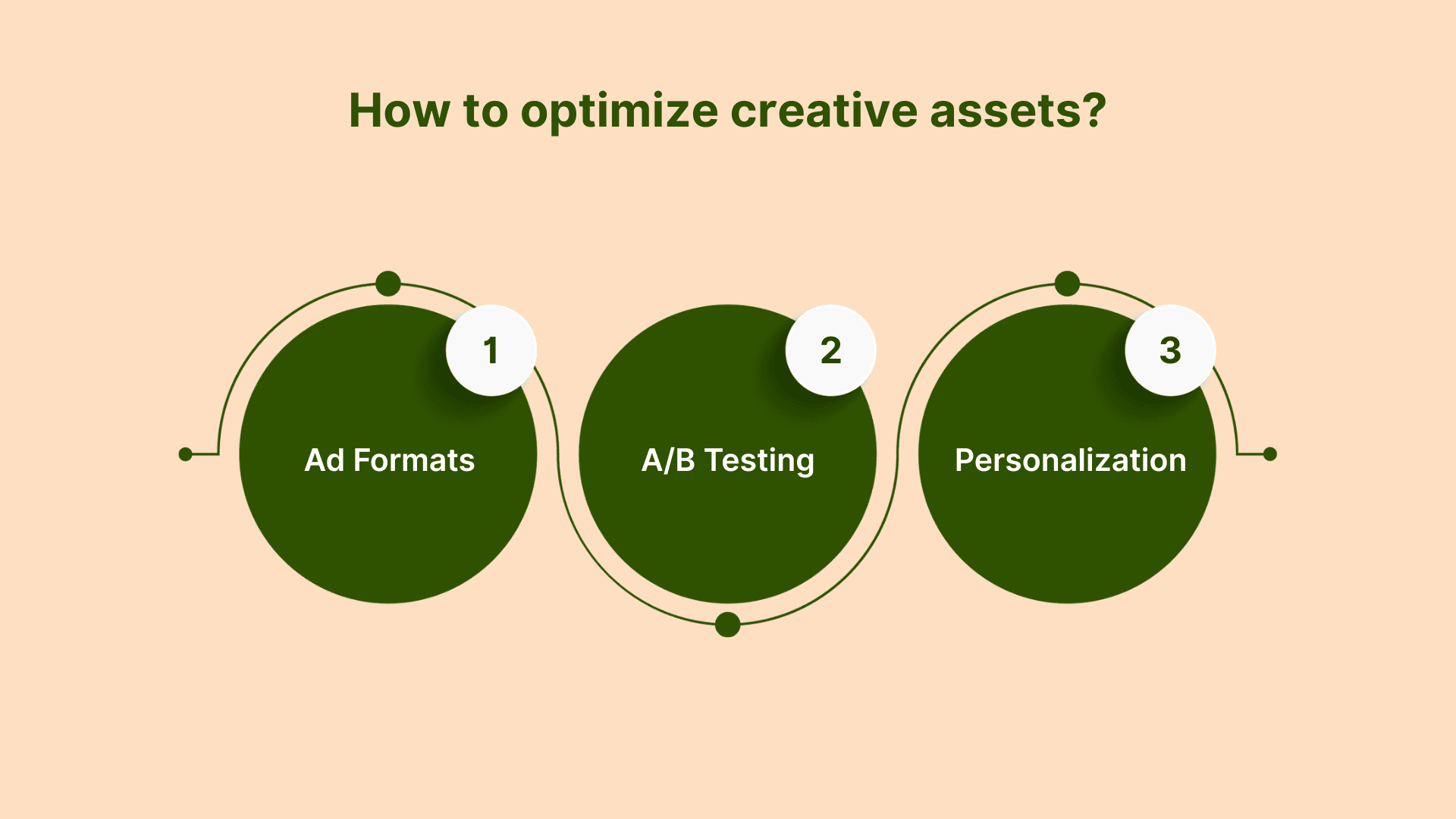
Ad Formats
Playable Ads: Playable ads are interactive advertisements that allow users to experience a mini-version of your game before downloading it. These ads provide a hands-on preview of the gameplay.
By engaging users in a brief, interactive experience, playable ads can filter in users who are genuinely interested in your game's mechanics. This hands-on approach captures attention and fosters engagement, resulting in higher conversion rates.
Video Ads: Video ads are dynamic advertisements that showcase your game's features, gameplay, and unique selling points through short video clips.
Video ads offer more context than images or text, providing users with a clearer understanding of how your game works and why it's valuable. They are particularly effective in influencing users' decisions to download your game.
A/B Testing
A/B testing involves comparing two versions of an ad to determine which one performs better. This method enables you to test various elements, including visuals, messaging, and call-to-action buttons.
By systematically testing different ad variations, you can identify the most effective creatives that resonate with your target audience. This data-driven approach ensures that your ads are optimized for maximum performance.
A/B testing eliminates guesswork from your advertising strategy, enabling you to make informed decisions based on actual user data. It helps in refining your creatives to better align with user preferences, leading to improved user acquisition outcomes.
Personalization
Personalization involves tailoring your ads to specific user segments. This could include customizing visuals, messaging, and offers to resonate with different audiences. Personalized ads are more relevant to users, increasing the likelihood of engagement and conversion. By addressing the unique needs and interests of each segment, you can enhance the effectiveness of your user acquisition campaigns.
Personalization improves ad recall and user engagement, leading to higher conversion rates. Ads that feel tailored to the individual are more likely to capture attention and drive installs.
3. Enhancing User Onboarding Experience
The user onboarding experience encompasses the initial interactions a new player has with your game, guiding them through its features and mechanics. A well-crafted onboarding process ensures that players understand how to navigate the game and what to expect, setting the stage for long-term engagement.
Why It Matters: The first-time user experience is critical in determining whether a player will continue engaging with your game. A seamless and engaging onboarding process can significantly improve lifetime value and player base.
Here is how you can enhance players onboarding experience:
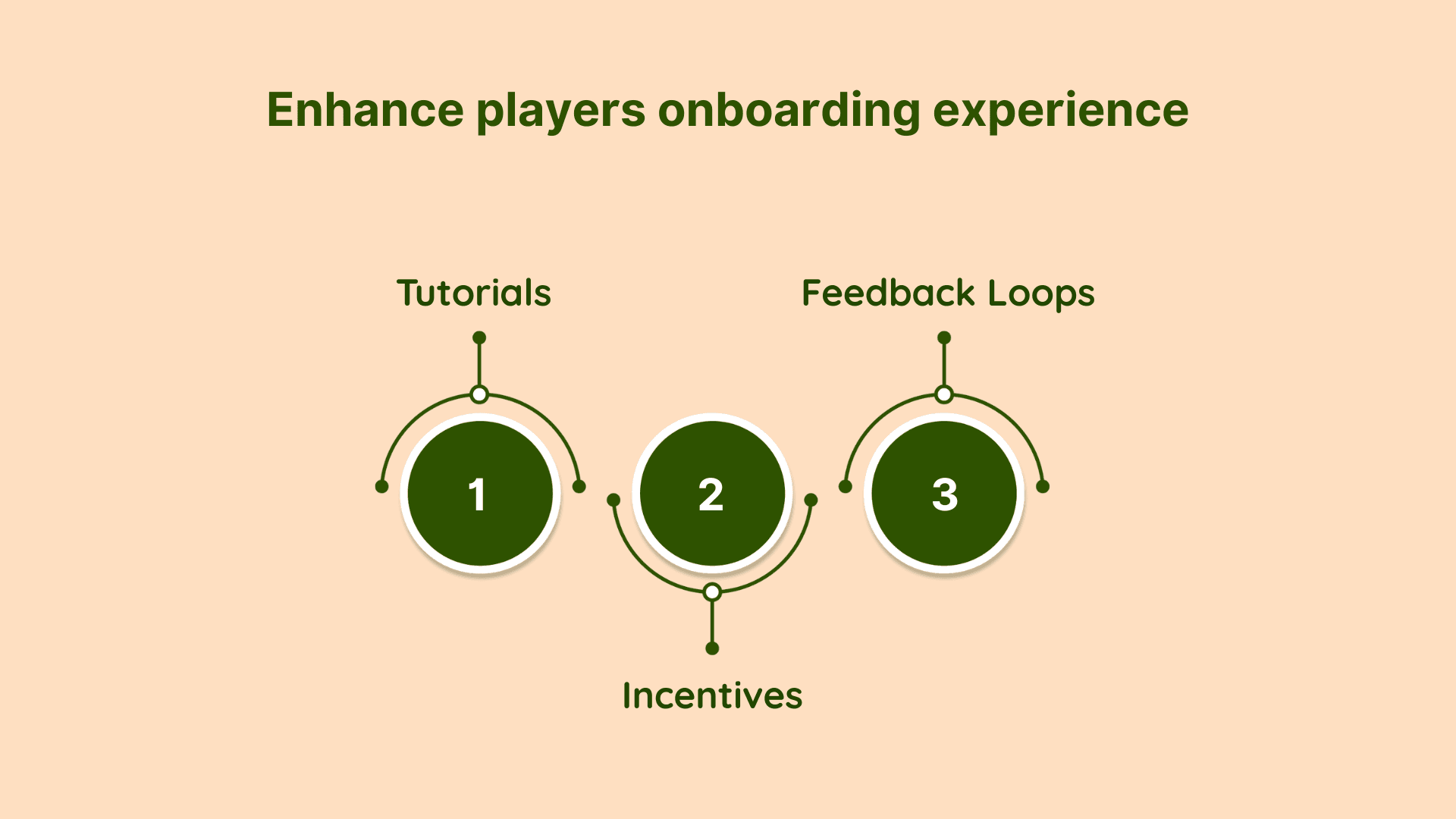
Tutorials
Tutorials are guided introductions that teach players the basic mechanics and objectives of your game. By providing step-by-step instructions, tutorials help players understand how to interact with the game, reducing confusion and frustration. This clarity encourages players to continue playing and explore more features.
Well-designed tutorials prevent frustration. They ensure that players understand how to enjoy and succeed in the game, enhancing overall satisfaction and player lifetime value.
Incentives
Incentives involve offering rewards or recognition for players who complete specific actions during the onboarding process. Incentives during the onboarding process are a powerful tool for boosting mobile game user acquisition. By offering tangible rewards early on, you can motivate new users to engage with your game.
Incentives matter because they provide immediate value to new users.. This approach not only attracts players but also fosters a positive first impression, which is crucial to scale the player base.
Feedback Loops
Feedback loops involve collecting player input through surveys or ratings and using this information to improve the game experience.By actively seeking and responding to player feedback, you demonstrate that you value their opinions, which can build trust and loyalty.
Implementing changes based on feedback shows players that their experience matters, leading to increased satisfaction. Continuous improvement based on user feedback ensures that the game evolves to meet player expectations. This responsiveness can differentiate your game in a competitive market, attracting more players.
4. Building a Strong Community
Building a strong community around your mobile game is not just a marketing tactic; it's a cornerstone of sustainable user acquisition. A dedicated community creates connections, promotes word-of-mouth, and encourages players to share their experiences, which drives organic user acquisition.
Why It Matters: A thriving community amplifies your game’s reach through user recommendations, leading to more downloads. Players who feel connected are more likely to return, engage, and invite others, providing valuable feedback and scaling your player base.
Here is how you can build a strong community:
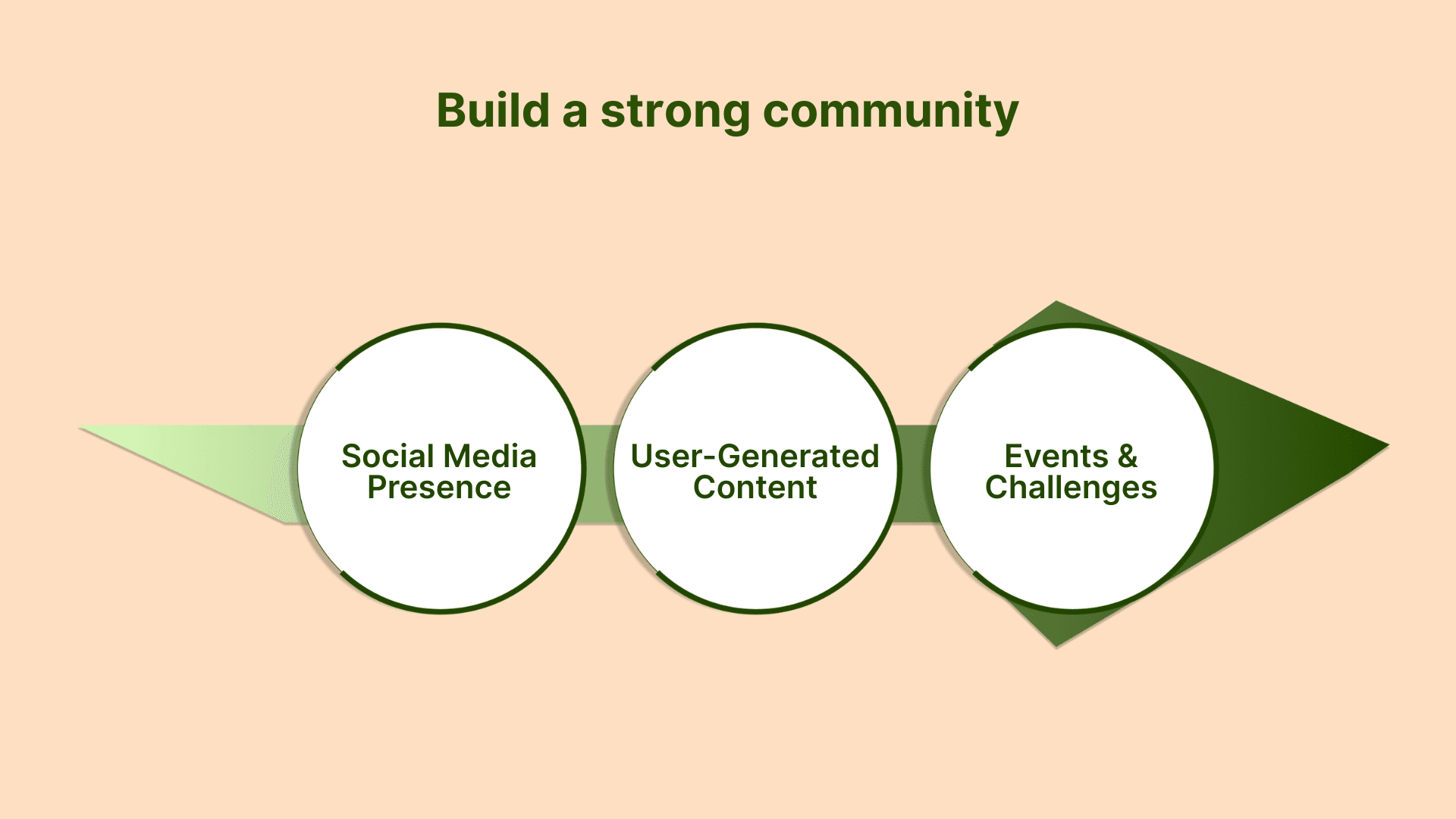
Social Media Presence
Maintaining active profiles on platforms like Instagram, Twitter, and TikTok lets you engage with potential players where they already spend time.
Regularly sharing updates and interactive posts keeps your game top of mind. This visibility can lead to increased interest and downloads as users become more familiar with your game.
A strong social media presence humanizes your brand and builds trust with your audience. Engaged followers are more likely to share your game with their networks, amplifying your reach and driving organic user acquisition.
User-Generated Content
Encouraging players to create and share content related to your game, such as fan art, gameplay videos, or memes. UGC ads act as authentic promotion, showcasing real players experiences. This organic content can go viral, reaching audiences beyond your immediate followers. Platforms like TikTok and Instagram are particularly effective for sharing UGC.
For example, Niantic, the developer of Pokémon GO, has effectively leveraged user-generated content (UGC) to enhance its mobile game user acquisition strategy. User-generated content in Pokémon GO includes photos, videos, and stories shared by players showcasing their experiences. They organized events like the #GOsnapshot challenge, encouraging players to capture and share their in-game encounters. This initiative boosts community engagement and also attracts new players through shared content.
Events and Challenges
Events and challenges are time-limited activities or competitions organized to engage players and attract new users. These can include tournaments, seasonal events, or community competitions that encourage participation and excitement.
By promoting these events on platforms like Instagram, TikTok, and Twitter, you create buzz and anticipation around your game. Sharing highlights and teasers related to the events can pique the interest of potential players, motivating them to download and join in. The sense of urgency and exclusivity associated with these events can drive higher conversion rates.
By strategically leveraging events and challenges, you can effectively increase your game's reach and user acquisition, turning casual observers into dedicated players.
5. AI-Powered Creative Optimization
In mobile gaming, capturing the attention of potential players is paramount. AI-powered creative optimization leverages advanced algorithms to refine ad creatives, ensuring they resonate with target audiences and drive installs.
Why it Matters: AI-powered creative optimization is essential for scalable game user acquisition. It enables precise targeting, proactive adjustments, and personalized ad experiences, leading to higher engagement and increased installs. By leveraging AI, you can optimize your ad creatives to resonate with your audience, improving your return on ad spend (ROAS) and overall campaign effectiveness.
Here is how AI helps in creative optimization:
AI Creative Analytics
AI Creative Analytics involves using artificial intelligence to analyze and interpret the performance of ad creatives. Segwise, an AI-powered platform, offers tools to optimize ad performance. Here is how:
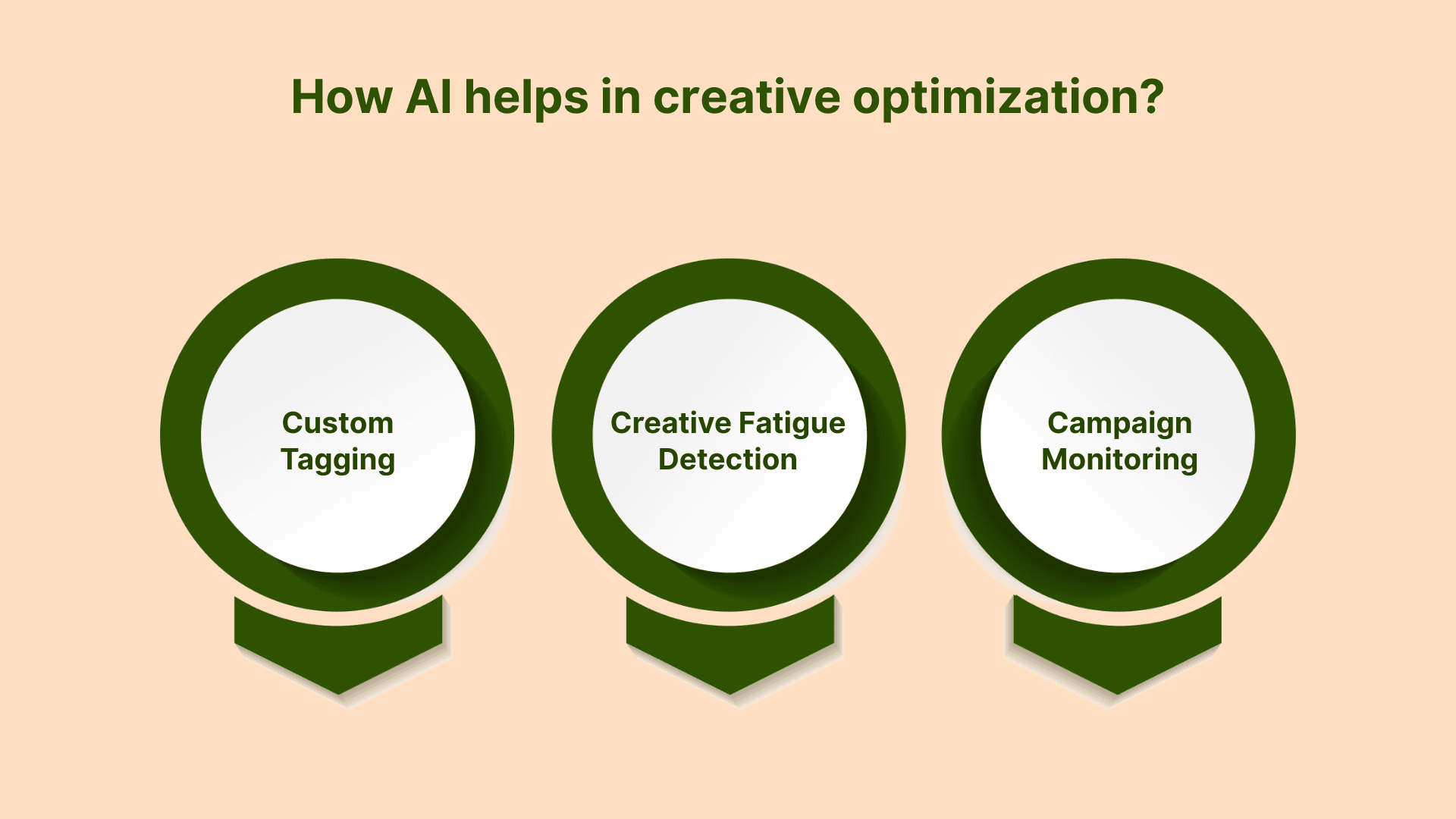
Custom Tagging: Custom Tagging provides a deeper understanding of creative performance, allowing you to refine your ads to attract new players better. This precision enhances the effectiveness of your user acquisition efforts.
Segwise's AI creative agent automatically tags creative elements such as visuals, text, audio, and other elements for all types of ad creatives across ad networks. Segwise supports over 20 predefined tags and enables the creation of custom tags tailored to your game's unique features.
Creative Fatigue Detection: Creative Fatigue Detection involves monitoring the performance of ad creatives over time to identify signs of declining effectiveness.
Segwise's Performance-Driven Optimization feature helps detect creative fatigue early by analyzing metrics such as CTR, CPI, and IPM. By identifying underperforming creatives, you can replace or refresh them promptly, ensuring your ads remain engaging and effective. This proactive approach prevents wasted ad spend and maintains a steady influx of new users.
Campaign Monitoring: Campaign Monitoring involves tracking the ongoing performance of your ad campaigns to ensure they continue to meet your goals. Segwise's AI-powered Campaign Monitoring Agent offers a proactive approach to campaign management, ensuring you catch issues before they drain your ad budgets.
AI Campaign Monitoring Agent continuously analyzes data from your Mobile Measurement Partners (MMPs) and ad networks to detect anomalies in your user acquisition campaigns. It provides deep insights into key performance metrics, alerting you to potential issues such as declining Return on Ad Spend (ROAS) or rising user Acquisition Costs (CAC).
Also Read: Creative Analytics Explained: How To Track, Measure, And Improve Ad Performance
Conclusion
In mobile game user acquisition, a strategic approach is key to standing out. By leveraging a hybrid acquisition model, optimizing creative assets, improving onboarding, building a strong community, and using AI-powered creative optimization, you can effectively attract new players. These strategies ensure sustained growth without increasing costs.
To supercharge your efforts, Segwise, an AI-powered platform, helps optimize ad creatives and campaigns. With features like creative AI agent, performance optimization, and AI campaign monitoring, Segwise enables you to enhance user acquisition and boost ROI.
So, why wait? Start your 14-day free trial today and elevate your user acquisition strategy!
FAQs
1. How can I assess the effectiveness of my ad creatives?
Utilize key performance indicators (KPIs) such as Click-Through Rate (CTR), Install Per Mille (IPM), Cost Per Install (CPI), and Return on Ad Spend (ROAS) to evaluate ad performance.
2. What is the significance of A/B testing in ad creative optimization?
A/B testing involves comparing two versions of an ad to determine which performs better. This method allows you to test various elements, including visuals, messaging, and call-to-action buttons, to identify the most effective creatives for user acquisition.
3. What benefits does a centralized dashboard offer?
A centralized dashboard integrates data from various ad networks and Mobile Measurement Partners (MMPs), providing a unified view of campaign performance. This facilitates quicker decision-making and more efficient campaign management.

Comments
Your comment has been submitted successfully!